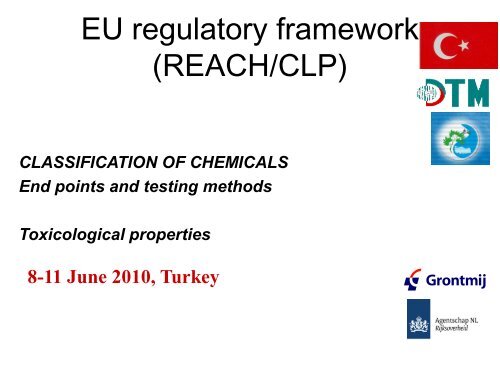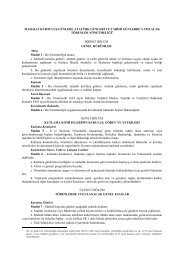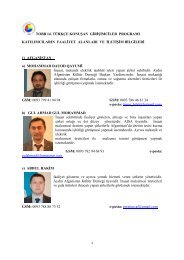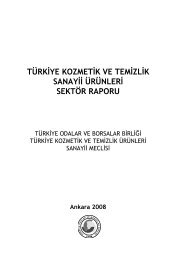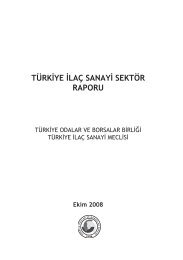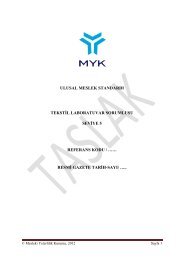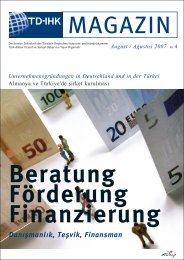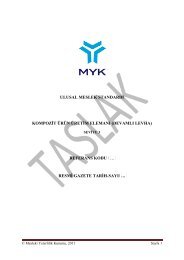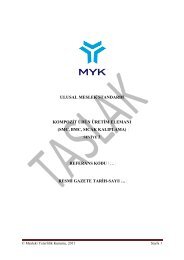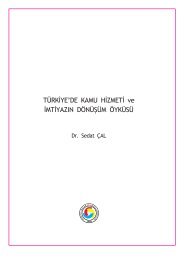EU regulatory framework (REACH/CLP) - TOBB
EU regulatory framework (REACH/CLP) - TOBB
EU regulatory framework (REACH/CLP) - TOBB
You also want an ePaper? Increase the reach of your titles
YUMPU automatically turns print PDFs into web optimized ePapers that Google loves.
<strong>EU</strong> <strong>regulatory</strong> <strong>framework</strong><br />
8-11 June 2010, Turkey<br />
(<strong>REACH</strong>/<strong>CLP</strong>)<br />
CLASSIFICATION OF CHEMICALS<br />
End points and testing methods<br />
Toxicological properties
Note 1- <strong>REACH</strong> Title XI<br />
Classification & Labelling<br />
<strong>REACH</strong> Title XI<br />
Proposals of conclusive classification and labelling (according to<br />
Directive 67/548/EEC) of registered substances need to be<br />
notified to the Agency (art. 112 en 113).<br />
Agency has set up & maintains classification & labelling inventory<br />
(art. 114).<br />
The <strong>EU</strong> version of the UN Globally Harmonized System (GHS)<br />
entered into force on 16 December 2008 (EC Regulation<br />
1272/2008)<br />
NB: Title XI will be deleted by December 2010 due to entry into<br />
force of Titles II-IV of new <strong>CLP</strong> Regulation (1272/2008)
Note 2: endpoints/testing methods<br />
modification brought by Directive 2006/121/ CEE removes the Annex V (testing methods)<br />
of the Directive 67/548/CEE<br />
DIRECTIVE 2006/121/EC of 18 December 2006 amending Directive 67/548/EEC<br />
"Article 3 - Testing and assessment of the properties of substances”<br />
Tests on substances carried out within the <strong>framework</strong> of this Directive shall be conducted<br />
according to the requirements of Article 13 of Regulation (EC) No 1907/2006 (<strong>REACH</strong>)<br />
10) Annex V shall be deleted;<br />
<strong>REACH</strong> Article 13 General requirements for generation of information on intrinsic<br />
properties of substances<br />
3. Where tests on substances are required to generate information on intrinsic<br />
properties of substances, they shall be conducted in accordance with the test<br />
methods laid down in a Commission Regulation or in accordance with other<br />
international test methods recognised by the Commission or the Agency as being<br />
appropriate<br />
Council Regulation (EC) No 440/2008 of 30 May 2008 laying down test methods pursuant to<br />
Regulation (EC) No 1907/2006 of the European Parliament and of the Council on the Registration,<br />
Evaluation, Authorisation and Restriction of Chemicals (<strong>REACH</strong>), whereas<br />
(3) The test methods contained in Annex V to Directive 67/548/EEC should be incorporated into<br />
this Regulation
How are dangerous substances classified –<br />
Health hazards<br />
DSD/DPD hazard classes <strong>CLP</strong> hazard classes<br />
Very toxic T+ Acute toxicity<br />
Toxic T Skin corrosion/irritation<br />
Corrosive C Serious eye damage/eye irritation<br />
Harmful Xn Respiratory or skin sensitisation<br />
Irritant Xi Germ cell mutagenicity<br />
Sensitising R42 and/or R43 Carcinogenicity<br />
Carcinogenic Carc. Cat. Reproductive toxicity plus additional<br />
category for effects on or via lactation<br />
Mutagenic Muta. Cat Specific target organ toxicity (STOT) –<br />
single exposure<br />
Toxic for reproduction Repr. Cat Specific target organ toxicity (STOT) –<br />
repeated exposure<br />
Aspiration hazard
How are dangerous substances classified –<br />
Environmental Effects<br />
DSD/DPD hazard classes <strong>CLP</strong> hazard classes<br />
Dangerous for the environment: N<br />
or/and R52, R53, R59<br />
Hazardous to aquatic environment<br />
Hazardous to the ozon layer
DSD/DPD hazard classes <strong>CLP</strong> hazard classes<br />
explosive: E Explosives<br />
oxidising: O Flammable gasses<br />
extremely flammable: F+ Flammable aerosols<br />
highly flammable: F Oxidising gases<br />
flammable: R10 Gases under pressure<br />
Flammable liquids<br />
Flammable solids<br />
Self-reactive substances and mixtures<br />
Pyrophoric liquids<br />
Pyrophoric solids<br />
Self-heating substances and mixtures<br />
Substances and mixtures which in contact with water<br />
emit flammable gases<br />
Oxidising liquids<br />
Oxidising solids<br />
Organic peroxides<br />
Corrosive to metals
Danger Symbols
WHERE TO FIND DATA REQUIRED FOR<br />
CLASSIFICATION AND LABELLING<br />
• Step 1: is your substance on the harmonised classification list?<br />
– If no, go to step 2<br />
– If yes, classify accordingly or justify new classifcation based on<br />
new evidence and submit Annex XV (<strong>REACH</strong>)<br />
Note: Already Labelled (harmonized-ATP)<br />
Annex 1 of Directive 67/548/EEC<br />
Search ClassLab database (via http://ecb.jrc.it/classification-labelling/)<br />
(Annex 1 of 67/548/EEC will be replaced by part 3 of Annex VI of <strong>CLP</strong><br />
Regulation 1272/2008 EC)<br />
• Step 2: you have data and self classification under old system<br />
– If yes: use translation tables<br />
– If no: go to step 3<br />
• Step 3: conduct base testing under <strong>REACH</strong> and gather additional<br />
relevant information and classify accordingly to Annex I
Oral –<br />
LD50<br />
(mg/kg bw)<br />
Endpoints acute oral toxicity<br />
DSD T+ R28 T R25 Xn<br />
≤ 5 5-25 25-50 50-200 200-300 300-2000<br />
<strong>CLP</strong> Cat. 1 Category 2 Category 3 Category 4
Endpoints acute dermal toxicity<br />
DSD T+ R27 T R24 Xn R21<br />
Dermal, rat<br />
or rabbit –<br />
LD50 (mg/kg<br />
bw)<br />
≤ 50 50-200 200-400 400-<br />
1000<br />
1000-2000<br />
<strong>CLP</strong> Cat. 1 Cat. 2 Category 3 Category 4<br />
Application: 10% of total body surface<br />
Exposure period: 24-hours<br />
Observation period: 14 days minimum
DSD<br />
Aerosols &<br />
particulates<br />
Inhalation,<br />
rat – LC50<br />
(mg/l)<br />
<strong>CLP</strong><br />
Dust &<br />
Mist<br />
Endpoints acute toxicity inhalation<br />
T+ R26 T R23 Xn R20<br />
≤ 0.05 0.05-0.25 0.25-0.5 0.5-1 1-5<br />
Cat. 1 Category 2 Cat. 3 Category 4<br />
Application: oro-nasal, head only or whole body<br />
Exposure period: 4-hours<br />
Observation period: 14 days minimum
DSD<br />
Vapours<br />
Inhalation,<br />
rat – LC50<br />
(mg/l)<br />
<strong>CLP</strong><br />
(gases)<br />
Inhalation,<br />
rat – LC50<br />
(ppm V)<br />
Endpoints acute toxicity inhalation<br />
T+ R26 T R23 Xn R20<br />
≤ 0.5 0.5-2 2-10 10-20<br />
Cat. 1 Cat. 2 Category 3 Cat. 4<br />
≤ 100 100-500 500-2500 2500-20000<br />
Application: oro-nasal, head only or whole body<br />
Exposure period: 4-hours<br />
Observation period: 14 days minimum
Specific Target Organ Systemic Toxicity – Single exposure<br />
DSD/DPD T+,R39 T,R39 Xn R68 R37 R67<br />
oral, rat (mg/kg bw/day) < 25 25-200 200-2000 R37 Irritating to<br />
dermal, rat or rabbit (mg/kg<br />
bw/day)<br />
inhalation (gas, vapour), rat<br />
(mg/l/4hr)<br />
inhalation (aerosols or<br />
particulates), rat (mg/l/4hr)<br />
< 50 50-400 400-2000<br />
< 0.5 0.5-2 2-20<br />
< 0.25 0.25-1 1-5<br />
<strong>CLP</strong> Cat. 1 Cat. 2 Cat. 3<br />
oral, rat (mg/kg bw/day) < 300 300-2000 Transient target<br />
organ effects.<br />
dermal, rat or rabbit (mg/kg bw/day) < 1000 1000-2000<br />
inhalation (gas), rat (ppm) < 2500 2500-5000<br />
Inhalation (vapour), rat (mg/l) 10 10 -< 20<br />
inhalation (dust/mist/fume), rat (mg/l/4hr) < 1 1- < 5<br />
small changes: body/organ weight, haematology<br />
adaptive responses: liver hypertrophy<br />
respiratory<br />
system<br />
R67 Vapours<br />
may cause<br />
drowsiness and<br />
dizziness.
Liver Hypertrophy<br />
Normal liver tissue Hypertrophic Liver tissue
Hyperplastic response<br />
Normal epithelium Hyperplastic epithelium
Classification Carcinogenic, Mutagenic,<br />
Reprotoxic (CMR)<br />
General under <strong>CLP</strong><br />
Category 1a: the substance is known to be CMR for man<br />
(epidemiological)<br />
Category 1b: the substance should be regarded as if they<br />
are CMR in man (evidence in more than 1 other animal<br />
species)<br />
Category 2 the substance cause concern for man (evidence<br />
one species, results variable etc.)<br />
NOTE classification somewhat different from eg. IARC classification
Steps in the Development of Tumours
Carcinogenic substances<br />
DSD Cat. 1 T R45 &<br />
T R49T+ R26<br />
Criteria Substances<br />
known to be<br />
carcinogenic to<br />
man<br />
Criteria Chemicals<br />
knows to have<br />
carcinogenic<br />
potential for<br />
humans<br />
Cat.2 T R45 & T R49 Cat.3 Xn R40<br />
Substances which should<br />
be regarded as if they are<br />
carcinogenic to man<br />
Chemicals presumed to<br />
have cancinogenic<br />
potential for humans<br />
Substances which<br />
cause concern for<br />
man owing to<br />
possible<br />
carcinogenic<br />
effects<br />
<strong>CLP</strong> Category 1 Category 2<br />
Category 1A Category 1B<br />
Suspected human<br />
carcinogens
Examples genotoxicity<br />
EXCISSION REPAIR<br />
MECHANISM<br />
DNA lesions<br />
(missing enzyme:example<br />
people sufferingfrom<br />
Xeroderma Pigmentosum)
Example genotoxicity<br />
Sister Chromatide exchange
Example Genotoxicity<br />
Sister Chromatide exchange
Genotoxicty and mutagenicity<br />
DSD Cat. 1 T R46 Cat.2 T R46 Cat.3 Xn R68<br />
Criteria Substances<br />
known to be<br />
mutagenic to man<br />
Substances which should<br />
be regarded as if they are<br />
mutagenic to man<br />
<strong>CLP</strong> Category 1 Category 2<br />
Category 1A Category 1B<br />
Criteria Chemicals knows<br />
to induce<br />
heritable<br />
mutations in germ<br />
cells of humans<br />
Chemicals which should<br />
be regarded as if they<br />
induce heritable<br />
mutations in germ cells of<br />
humans<br />
Substances which<br />
cause concern for man<br />
owing to possible<br />
mutagenic effects<br />
Chemicals which cause<br />
concern for man owing<br />
to the possibility that<br />
they may induce<br />
heritable mutations in<br />
germ cells of humans<br />
Genotoxicity: direct and indirect effects on genetic material (broader incl.<br />
for example sister chromatide exchange mechanisms)<br />
Mutagenicity: induction of permanent transmissible change in amount or<br />
structure of genetic material
Specific locus muation test (visible)
Reprotoxic substances<br />
DSD Cat. 1 T R60 & T<br />
R61<br />
Criteria Substances known<br />
to impair fertility in<br />
humans or to cause<br />
developmental<br />
toxicity in humans<br />
Cat.2 T R60 & T R61 Cat.3 T R62 & R63<br />
Substances which<br />
should be regarded as if<br />
they impair fertility to<br />
humans or cause<br />
developmental toxicity<br />
in humans<br />
<strong>CLP</strong> Category 1 Category 2<br />
Category 1A Category 1B<br />
Criteria Chemicals knows<br />
human reproductive<br />
toxicant<br />
Chemicals presumed<br />
human reproductive<br />
toxicant<br />
Substances which<br />
cause concern for<br />
human fertility or to<br />
possible developmental<br />
toxic effects<br />
Chemicals suspected<br />
human reproductive<br />
toxicant


